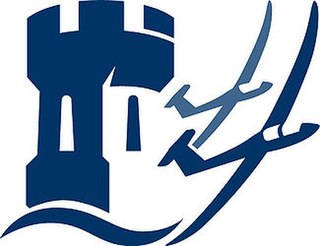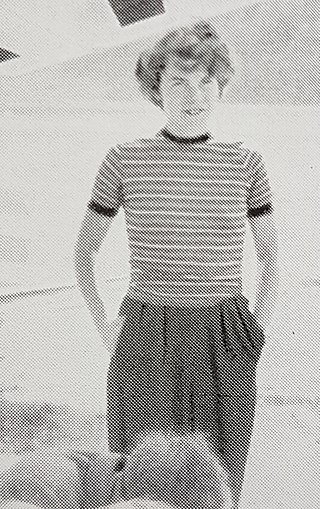
Squadron Leader Robert Kronfeld, AFC was an Austrian-born gliding champion and sailplane designer of the 1920s and 30s. He became a British subject and an RAF test pilot. He was killed testing a glider in 1948.

Alan Derek Piggott was one of Britain's best known glider pilots and instructors. He had over 5,000 hours on over 153 types of powered aircraft and over 5,000 hours on over 184 types of glider. He was honoured for his work on the instruction and safety of glider pilots. In 1961 he became the first person to make an officially authenticated take-off and flight in a man-powered aircraft. He also worked as a stunt pilot in several feature films.

The University of Nottingham Gliding Club is the gliding club of the University of Nottingham. The aim of the club is to provide affordable flying in order to introduce as many members as possible to unpowered flight. Affiliated with the Cranwell Gliding Club (CGC), the club is open to any full or associate member of the University of Nottingham Students' Union.
George B. Moffat Jr. (1927–2024) was an American author, twice world champion glider pilot, and a member of the U.S. Soaring Hall of Fame. He began flying airplanes in 1953, gliders in 1959, entered his first national soaring competition in 1962, and was still an active competition pilot as of 2008. Before competing in sailplanes, he compiled a winning record in International 14 foot Dinghy racing.

Ann Courtenay Welch OBE, née Edmonds, was a pilot who received the Gold Air Medal from Fédération Aéronautique Internationale (FAI) for her contributions to the development of four air sports - gliding, hang gliding, paragliding and microlight flying. She flew as a ferry pilot in the Air Transport Auxiliary during the Second World War.

Philip Aubrey Wills CBE was a pioneering British glider pilot. He broke several UK gliding records from the 1930s to the 1950s and was involved in UK gliding administration including being Chairman of the British Gliding Association (BGA).

Sebastian Kawa is a Polish glider pilot, eighteen-time World Champion, FAI world leading glider competition pilot and the current World Champion in 15m Class and European gliding champion in 18m Class. In 2024, together with Sebastian Lampart, he became the first pilot in aviation history to fly over K2 in a glider.
Hans-Werner Grosse was a German Luftwaffe bomber pilot and glider pilot who established 50 world records approved by FAI Gliding Commission.
Richard H. Johnson was a glider pilot, aeronautical engineer and prolific writer of articles for gliding magazines. He was an 11-time U.S. National Champion glider pilot, 9-time US Soaring Team pilot at the Soaring World Championships, held two World Gliding Records and is a member of the US Soaring Hall of Fame. He flew for 70 years and logged over 14,000 flying hours, including over 10,000 hours of non-powered flight time in sailplanes. He authored over 100 articles on soaring and flight tests of gliders.

Rear Admiral Hilary Charles Nicholas Goodhart CB FRAeS was an engineer and aviator who invented the mirror-sight deck landing system for aircraft carriers. He was also a world champion and record breaker in gliding.

Gliding is a recreational activity and competitive air sport in which pilots fly unpowered aircraft known as gliders or sailplanes using naturally occurring currents of rising air in the atmosphere to remain airborne. The word soaring is also used for the sport.
Anne Burns was a British aeronautical engineer and glider pilot. She had a career of nearly 40 years in the Royal Aircraft Establishment as an engineer and an expert in wind shear. As a glider pilot, she holds the British record for highest altitude, and was the first woman to cross the English Channel in a glider.

A glider or sailplane is a type of glider aircraft used in the leisure activity and sport of gliding. This unpowered aircraft can use naturally occurring currents of rising air in the atmosphere to gain altitude. Sailplanes are aerodynamically streamlined and so can fly a significant distance forward for a small decrease in altitude.
The Applebay Zuni and Zuni II are single-seat, water-ballasted gliders designed to compete in the FAI 15m class.

The Slingsby T.59 Kestrel is a British Open class glider which first flew in August 1970. Of fibreglass construction, it features camber-changing flaps, airbrakes, and a retractable main wheel.

The Handasyde glider was a single-seat monoplane glider, designed specifically for the first British gliding competition held at Itford Hill in 1922, an endurance event. It finished in second place to a French tandem-wing machine.
The Gordon England glider was a single seat glider designed specifically for the first British gliding competition held at Itford Hill in 1922, an endurance event. It made some competition flights but was damaged on the last day.
The Brokker was a single seat glider entered into the first British gliding endurance competition, held at Itford Hill in 1922. It combined the wing of a Fokker D.VII with an engineless Bristol F.2 Fighter fuselage. It flew well in the stiff winds of the last day and achieved the third longest flight.
Walter Anselm Henry Kahn MBE was a key figure in the development of gliding in Britain after the Second World War.











